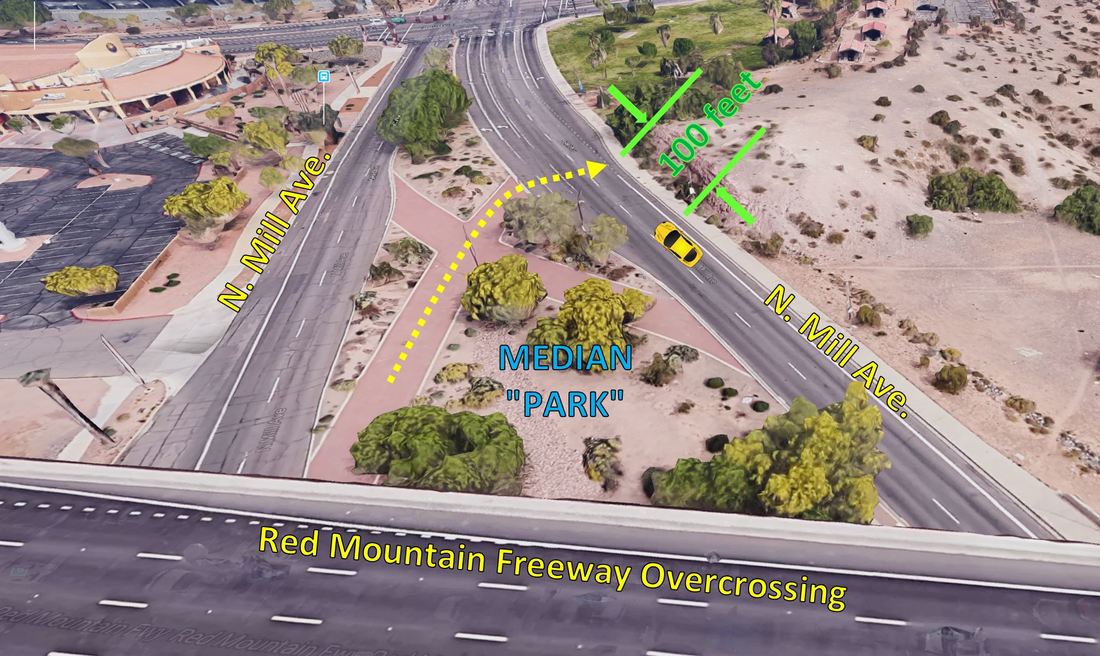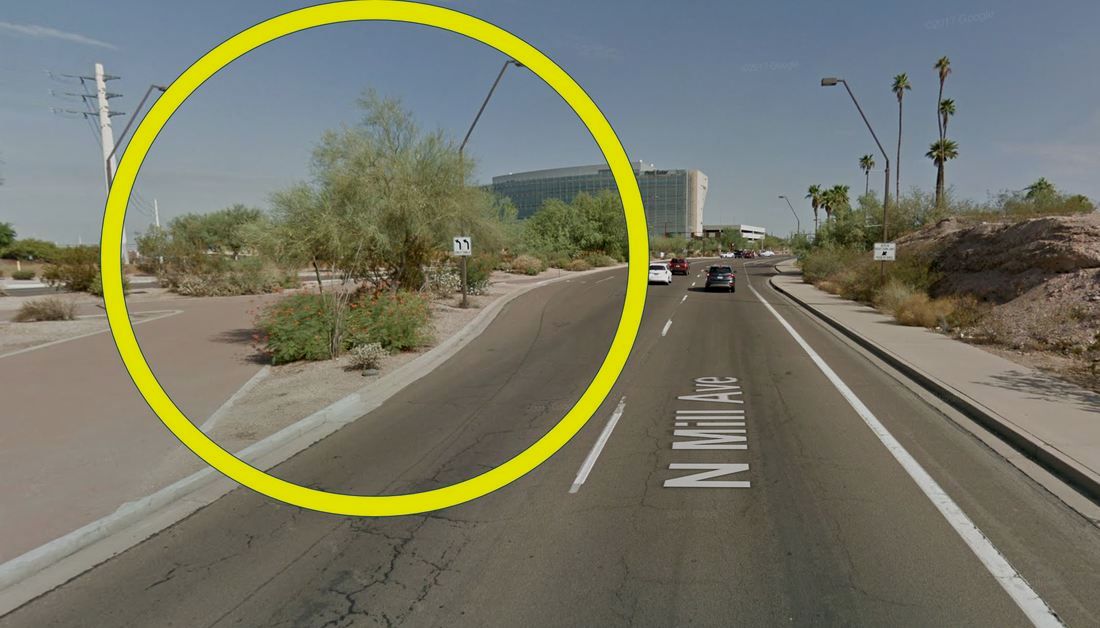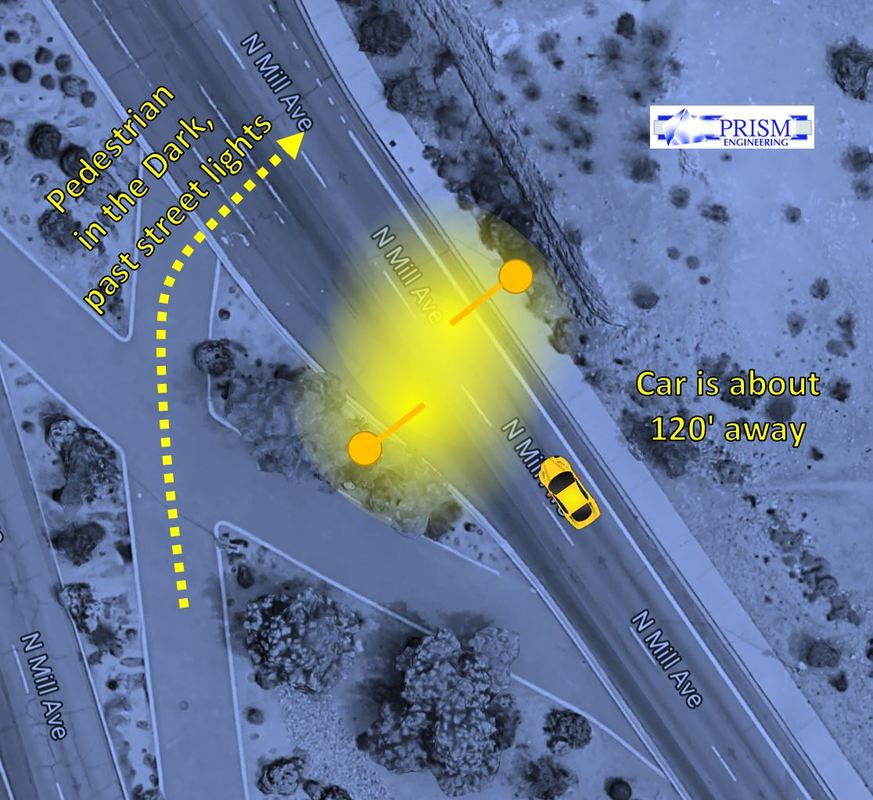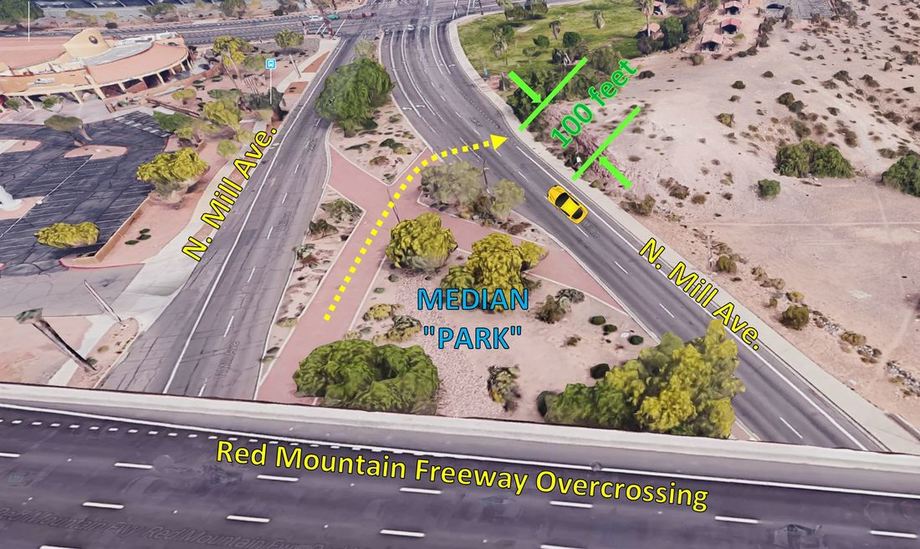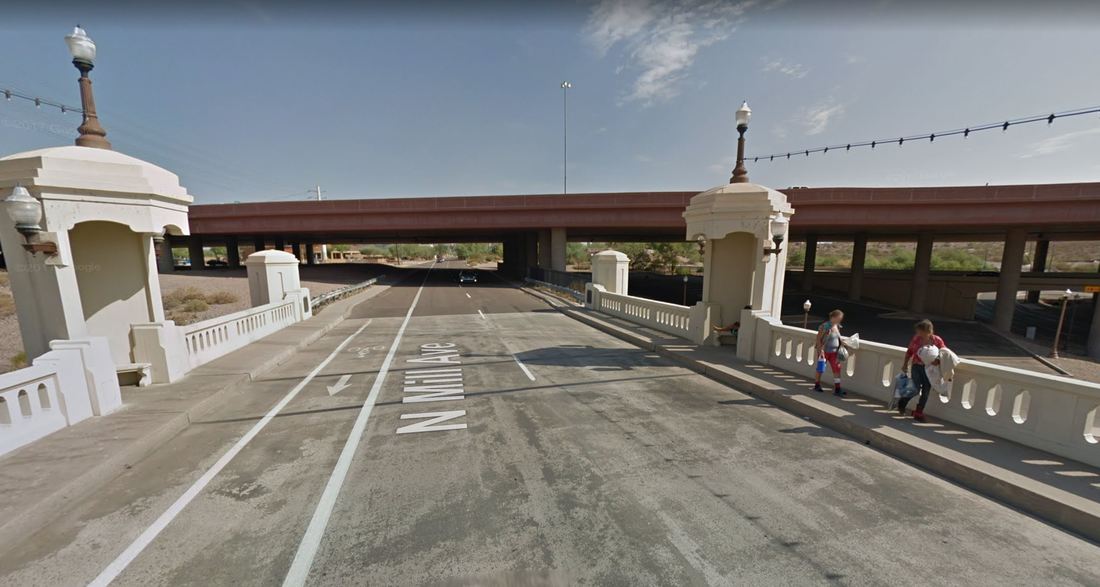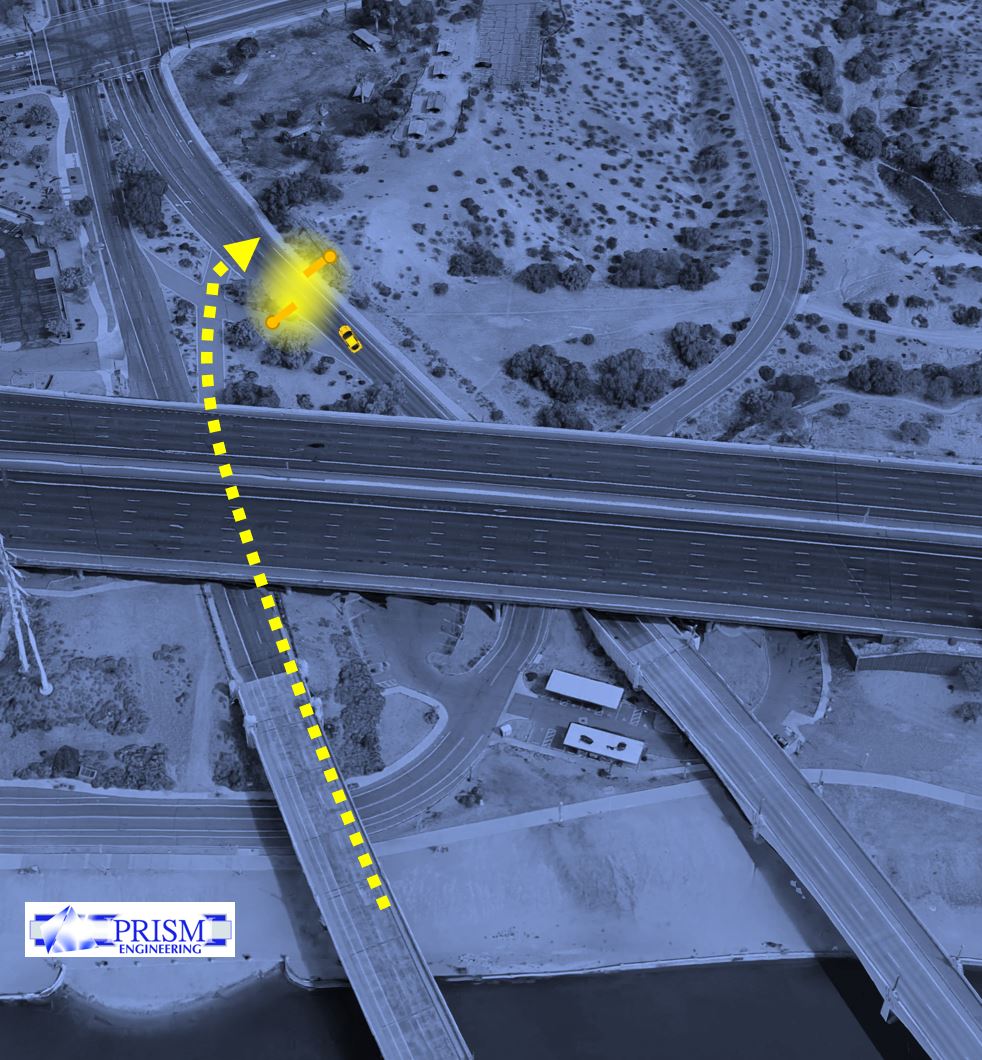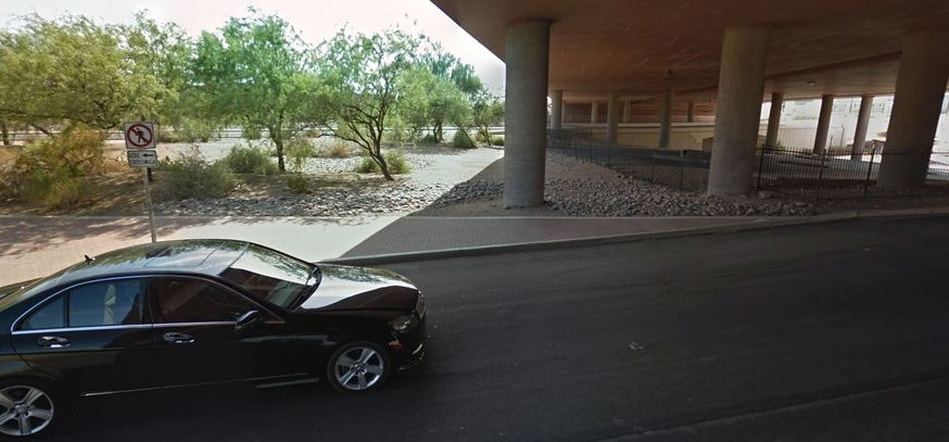Yes, the UBER Autonomous Car FAILED to react in time, but...
given ANY other car with a human driver, ...the same accident would have happened.
It is shocking that the UBER autonomous car FAILED to even slow down, and they need to look into that, BUT... a human would have failed to slow down too because of the simple physics of the situation. By the time a human could have possibly even seen this pedestrian in the dark, they physically could not get their foot to the brake in time to slow down. It takes time.
Based on this fact, there is no way this woman pedestrian would have had any better outcome, given the lack of time.
Read on...
Based on this fact, there is no way this woman pedestrian would have had any better outcome, given the lack of time.
Read on...
|
Illustration: Grant Johnson, TE. (Illustration labeled and notated on top of Google Maps Aerial at accident site, looking north)
Note: dotted yellow line shows travel path of a pedestrian using paved walkway, and entering Mill Ave. by J-WALKING. Yellow car is in approximate same location of the UBER autonomous car at the time of first visibility with headlights of the pedestrian crossing the street. |
Being reasonable, there seems to be liability on all sides enough to go around. Unsafe crossing by a pedestrian, unsafe inattentive driving, failing autonomous detectors or software, strange median designs, lack of street lighting in the right places, pedestrian pathways leading to dangerous places, etc.
No human could have stopped in time, there wasn't enough PERCEPTION TIME, or REACTION TIME, let alone braking time. Total distance needed to stop: 300 feet according to Caltrans. The woman pedestrian shows up on camera at approximately 100 feet. This is also the distance when a human could see her according to definitive studies of pedestrian visibility at night with dark clothing. 60 feet is the distance traveled during the perception time (for a human) traveling at 40 mph. Also we know from several studies that humans can't see so well at night. In fact, in testing, humans 65 and older can only begin to see a pedestrian in the dark dressed in dark clothing at about 65 feet. Young people 18-30 as much as 105 feet. This correlates with the video below. You can only perceive what you can see. Let's also not forget about the environment. It practically INVITED this lady to cross the street where she did, at about the most dangerous place you could jaywalk, she was on a sidewalk in the median that actually LED HER THERE. The median was decorated just like a park, and had a sidewalk that led to it from the bridge, but had no way out except to J-WALK. This is a liability too. It is a pedestrian trap. |
Bloomberg Forensic crash analysts who reviewed the video said a human driver could have responded more quickly to the situation.
Really?
|
When I read this sensational article, I cringed at the bold statement.
It's just, not possible. I too reviewed the video numerous times. The pedestrian was wearing DENIM pants and a BLACK shirt. Her bike was behind her and had no visible reflectors. She was not looking up at oncoming traffic. Was she exhausted and unaware of her surroundings? I could see that there were only THREE lane stripes visible between the vehicle and the pedestrian, a distance of about 100 feet on Mill Ave. between the vehicle and the pedestrian. That is a very short distance for 40 mph. For a human driver surprised with this at 100 feet, nothing can be done. This would be during the time of "perception" of danger taking place if a driver is alert. Reviewing the "Safe Stopping Sight Distance" standards from Caltrans Highway Design Manual Table 201.1 , it shows the stopping sight distance standard for a vehicle traveling 40 mph (the speed of the UBER car) to be 300 feet of distance to safely stop. There was only 100 feet. How is it then that these analysts are stating that a human could have responded quicker, when the factual traffic engineering knowledge in place says that more than three times the distance would be needed (300 feet needed to prevent collision) ? Even before a human begins to hit the brake, nearly 150 feet has been traveled by the car. Clearly hitting the pedestrian at FULL SPEED. |
The pedestrian hit by the UBER autonomous car was wearing a black shirt, and Levis.
Even if this driver were paying complete attention, she would have still hit the pedestrian.
|
STUDIES on VISIBILITY at NIGHT with DARK CLOTHES
|
The pedestrian hit by the UBER autonomous car was wearing a black shirt, and Levis, and J-WALKING across a high speed road at night with no effective street light illumination.
|
STUDIES* show that drivers at night have difficulty seeing a pedestrian with dark clothes. Conclusions of study show the driver suddenly sees the pedestrian as follows:
Visibility of a Young Person: Age 18-30 = 105 feet Visibility of an Old Person: Age 65+ = 65 feet *Source: Olson PL, Sivak M These are measurements while driver is looking slightly to the left of lane, and this visibility is also related to the fact that headlights are slightly aimed more to the right than they are to the left, a safety feature for not blinding oncoming traffic. |
Bloomberg Analyst states that UBER car should have detected pedestrian in median, and BRAKED.
Really?
|
False. First of all, there is a little grove of trees and thick brush between the car's vantage point (see yellow circle) and where the pedestrian/bike would have been in the median before deciding to enter the road. Is that how we humans drive, when we see a pedestrian near the edge of a roadway, we begin to brake?
Hardly. We sail on past unless they enter the road. Why would programmers make autonomous vehicles brake whenever a pedestrian is detected walking that is not in the road? Its ridiculous to assume that, that moving pedestrians on edges of roads will suddenly walk into the path of high speed traffic, and to brake, just in case they do. Traffic would all move very slowly if this were the case.
Also, there is no way software using LIDAR could effectively detect a human behind a grove of trees and leaves and bushes blocking the view, anymore than it could detect a pedestrian about to come around the corner of a building. It would not recognize it just like a human would not recognize it because they actually can't see it at all, in the dark. When a pedestrian gets in front of us, then is the time that we will brake, not when they are behind trees and bushes where we can not see them or prepare for their entry into the road, because they are hidden, even at night. These newspaper analysts are assigning blame to autonomous technology as if a human could have done a better job of it, as if they know, ...they don't know. The fact is, when pedestrians suddenly enter a high speed road into oncoming traffic, it takes a certain significant distance for a driver to first,
1) PERCEIVE that they need to brake, then 2) REACT by engaging their foot to the brake (or alternatively, swerving), and then the 3) BRAKING time after the first two time periods to bring the vehicle to a stop, a time which depends on weather, tires, friction, weight of vehicle, etc etc. The first step, in this case at 40 mph, takes 60 feet to perceive. The second step takes at least that long again, to react and move a foot to the brake, so the vehicle has effectively already moved 120 feet, at least, before the vehicle even begins to mechanically slow down by the braking process. The pedestrian is not even seen before 105 feet by a young driver, 65 feet by an old driver, so the pedestrian will be hit at FULL SPEED in ANY case with a human driver. You can't brake for that which you can not see. UBER had a chance to improve on this with LIDAR technology, but UBER did fail to deliver on shaving down that 120 feet traveled during Perception and Reaction time. On an autonomous vehicle this is theoretically supposed to be a near zero time, instantaneous computer processing, so they say. Was UBER software still trying to calculate what in the world it was seeing? If it knew, it could have saved this woman, like no other human possibly could. So I say, let's not bag on UBER and autonomous vehicles in general, let's be reasonable and hope for better autonomous reactions in highly confusing situations in the future. Back to the Drawing Board for night time situations with pedestrians dressed in dark clothes, with high speed vehicles, trees, and J-WALKING pedestrians who are being unsafe. |
source: Google Street View, and notated by Grant Johnson, TE
Street Lights (luminaires) are in the Wrong Place.
|
There is a lot of LIABILITY to go around here, in Road Design, in Pedestrian and Bicycle Safety too.
Maybe it is just me, but this median looks really intriguing and attractive. It actually looks like a park. But it's between two high speed roads and there are no fences.
|
It looks like a park complete with trees, paved pathways, and large rocks.
It looks inviting. The pathways lead to somewhere. All that is missing is a couple of park benches. But this "park" is in the wrong location. And at night, there is a serious problem with lighting in the wrong places, and pathways leading to a JWALK situation without a crosswalk or warning signs. At the ground level, it is confusing for both pedestrians and drivers who may see a pedestrian crossing in a strange place, unexpected and surprising. |
IF YOU BUILD IT, THEY WILL COME
|
After taking a tour with Google street view, I could see that there is a sidewalk on a connecting bridge on the same side as the median, that actually leads pedestrians into this DEAD END median "park" complete with paved pathways but no way out, except to J-WALK.
In the Street View above, note the pedestrians present on the sidewalk that leads to this park-like median which is just past the freeway. There is even a pedestrian sitting booth on both sides of the bridge here, a bridge with no way out up ahead.
It is a beautiful walkway on the bridge, but with dead ends at both ends of the bridge. Why are pedestrians using it? If you build it, they will come. Note: this bridge is one-way traffic for the SB traffic, Mill Ave. |
This aerial view of the accident location shows the pedestrian pathway that is now in place coming from the bridge for SB traffic (this same scenario exists on the twin bridge for NB traffic). The location of the car and street lights are also shown, representing the time when a human could have seen a pedestrian dressed in dark clothes J-WALKING across Mill Ave. in the NB direction.
source: Google Aerial View, and notated by Grant Johnson, TE
|
A Dead-End sidewalk, with no safe way out, and no warnings for PEDS already in the median.
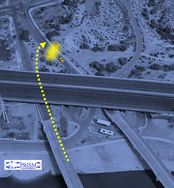
Sure, there is a sign there that says NO PEDESTRIANS and USE CROSSWALK (see photo below), but look at what direction it is facing. It is facing west, perpendicular to the median, apparently to warn pedestrians on the west side sidewalk to not cross over into the median. But if you are a pedestrian walking from the bridge on that side of this one way segment of road, you will not see this sign. You have no warnings on the bridge. In fact, if a pedestrian tried to view this sign they might interpret it to mean, "continue forward to the crosswalk" (in the direction of the arrow) rather than cross to leave the median. Then the pedestrian has this beautiful paved brick pathway that leads them, not to a crosswalk, but to a curb, faced with a decision to cross four lanes of high speed traffic without a crosswalk, without a warning, without a street light.
I can see many pedestrians making a serious mistake with this kind of design and lack of guidance. I believe there is serious liability here.
I can see many pedestrians making a serious mistake with this kind of design and lack of guidance. I believe there is serious liability here.
|
Architects, Planners and Engineers in their quest to make beautiful transportation facilities need to also think about safety in design and how the user will use the feature or facility. They must also think about if the transportation "art" is confusing, especially from a safety standpoint. This particular design should have had fences, no paved pathways to confuse, and certainly some guidance to peds. The pathways in no case should have connected directly to the curbs of the roadway as if to lead a pedestrian there. The bridge should not have encouraged pedestrians to use the median side of the bridges, as this can only lead to this dead end, on both bridges!
Also, a pedestrian seeing a paved pathway, a short cut, and a sign that says in effect "don't use me" is a very mixed message. source: Google Street and Aerial View, and notated by Grant Johnson, TE
|
|
Published March 20, 2018
Article Author: Grant Johnson, TE, registered Traffic Engineer in State of CA |
